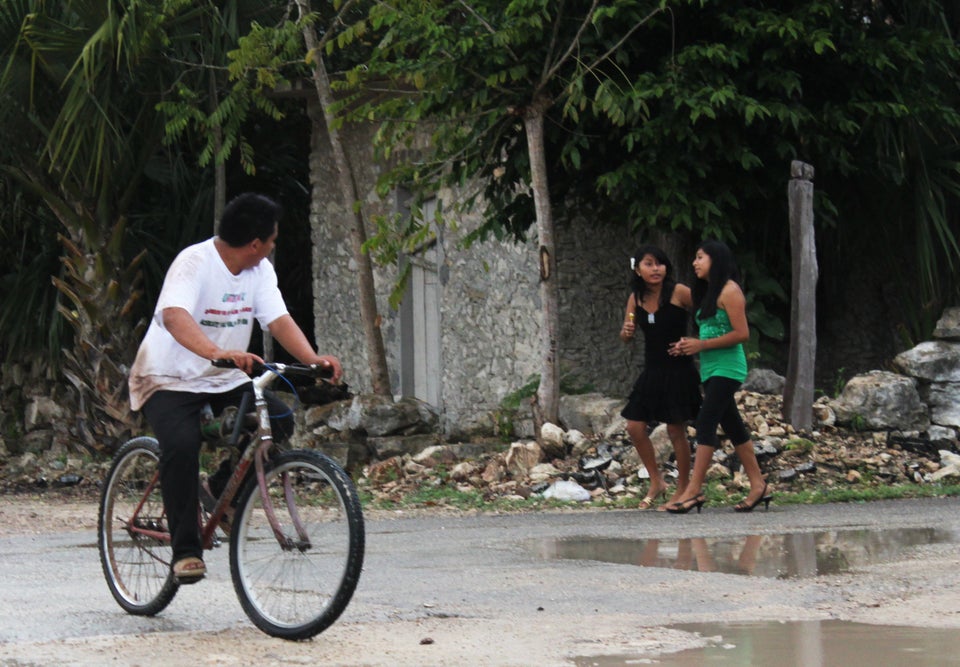San Juan de Dios, Mexico is an unremarkable town 10 kilometers into the forest south of the ruins at Coba, where tourist buses park next to a shallow, crocodile-infested lagoon. There are no buses here, just a main square with a gazebo and the sound of soft Mayan consonants swishing from the PA system jerry-rigged above the police station.
I've come here to ask some actual Maya people about the so-called apocalypse said to be prophesied by Coba's Stela 1, a chunk of elaborately carved limestone much scrutinized by day-trippers down from Cancun. I'm keenly aware that the doomsday warning has been inflated by members of the media like myself and I'm ready for my penance, prepared to be treated as the village idiot.
That I'm not is more of a testament to the patience and politeness of San Juan's Maya community than it is to the veracity of the claims that have resulted in a scramble for hotel rooms in nearby Valladolid. The men I speak with -- women in floral Yucatecan dresses giggle and flee my presence -- listen thoughtfully to my questions and pause to consider the inconsiderate queries before responding.
Policarpo Dzib Dzib, who looks to be in his early 50s and sports a neatly groomed Hitler mustache, leans against the counter of his grocery for a minute before shaking his head. He has several colorful displays boasting an almost incalculable variety of flavored chips.
"I think the 21st is only the end of the calendar year," he says. "I do not think this is the end of the world."
December 21, it should be noted, is the end of every Maya calendar year and Policarpo, it should also be noted, is a Christian who doesn't know very much about the ancient gods. He believes in the apocalypse as foretold in the Book of Revelation, but doesn't "know any better than anyone else when that will happen."
Sebastian Dzib Canul, who I find taking a nap in a hammock behind his pharmacy, makes a similar point.
"I'm sure we Maya have a different way of seeing the world," he says, "but we don't know anything other people don't know."
Sebastian is young and carries himself with a great deal of confidence, but he seems almost ready to apologize for not being a seer. He says he wishes he knew about world events before they happened.
The apocalyptic prophesies of a dismantled empire hold a special weight because absence -- especially mysterious absence coupled with glorious ruins -- is so easily mistaken for credibility. Taking Maya prophecy seriously is made significantly easier for believers and New Age types by the lack of traditional Maya holy men running around. Sebastian, for one, is wearing a Nike quick-dry shirt and has what can only be described as an excellent haircut.
Because Maya priests don't practice the elaborate ceremonies they once did, there is no need for those eager to believe in prophecies to confront the ridiculousness inherent in any belief.
Rolando Canul Canul, who is waiting out a rain storm under the eaves of thatch-roofed home, tells me he doesn't know why people are so interested in Maya beliefs.
"I think maybe we are a spiritual people and we have been here a long time," he says. "That does not mean we know anything. We practice the old ceremonies because it is tradition, and the tourists come and look at the altars we set up in the caves."
Rolando, suffice it to say, isn't settling his affairs.
I wander up and down the town's dirt roads, which overlap in a neat grid before crashing into the forest, and marvel at the gardens surrounding some of the neater wooden constructions. Coca-Cola bottles and Sol beer logos are painted on stucco walls. Several more men treat me with polite indifference, reassuring me that the world won't end or apologizing for their lack of Spanish with upturned palms.
The only person I find willing to engage with the prophecy is Jeremias Kulaak Paal, who works as a waiter in Bahia Principe. Jeremias slips a memory card into his Nokia phone and shows me a video explicating the prophecy and its connection to nearby Coba. He says he was curious after seeing reference to the apocalypse on the Internet and went to see the stone. After that he had some questions for his 109-year-old grandfather.
"My grandfather told me that there will be a change after the new year," says Jeremias, who has just grown out of his teens. "He says that there will be more peace and prosperity going forward, so I think we should look forward to it."
This cheerful perspective actually lines up neatly with what archeologists and anthropologists say about the significance of this new year. On or around the solstice, the b'ak'tun, a Maya measurement of time roughly equal to 394 years, will end. The end of this period is traditionally interpreted as a time of significant change.
"The world isn't going to end, but it might get better," concludes Jeremias.
He's friendly and plainly enjoys trying out the English words he's learned on the job. I ask him if he'll go into Coba and celebrate with the tourists. He shakes his head.
"We're going to get beers and have a party in town," he says. "Nothing big."
